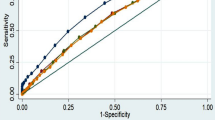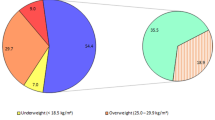Abstract
OBJECTIVE: To assess the predictive value of central obesity for risk of ischaemic heart disease (IHD) in a long-term follow-up, measured by skinfold thickness in comparison to general measures of overweight and obesity such as Quetelet's index.
SUBJECTS AND DESIGN: A total of 2512 men aged 45–59 y from the general population first examined in 1979–1982. Men were re-examined at approximately 5 y intervals. All fatal and non-fatal cases of IHD during a 14 y follow-up were recorded.
MEASUREMENTS: Skinfold thickness was measured at four sites. Height (m) and weight (kg) were also measured and Quetelet's index (weight/height2) was used as the reference body mass index (BMI).
RESULTS: Data were available for 2512 men among whom 411 new cases of IHD (fatal and non-fatal) occurred during 14 y of follow-up. Increasing values of BMI showed a statistically significant trend with increasing risk of new IHD that contributed independently to risk of IHD when adjusted for age, smoking habit and social class. Skinfold thickness measures were entered singly and in combination into this model with and without the additional inclusion of BMI. All individual skinfolds were significantly associated with risk of new IHD when BMI was excluded from the regression model, as was the sum of four skinfolds and the sum of subscapular and abdominal skinfolds. Only the subscapular skinfold measure contributed independently to risk of subsequent IHD when BMI was included in the model although biceps, biceps plus triceps and total sum of skinfolds were close to achieving statistical significance. The relative odds of IHD in the upper quintile of subscapular skinfold compared to the lowest was 1.9 (95% CI 1.3–2.8) when adjusted for age, smoking habit and social class.
CONCLUSIONS: In general skinfold measurements contribute only marginally to improved prediction of risk of IHD as measured by BMI, but central obesity, as measured by the subscapular skinfold, is predictive of IHD independently of BMI.
This is a preview of subscription content, access via your institution
Access options
Subscribe to this journal
Receive 12 print issues and online access
$259.00 per year
only $21.58 per issue
Buy this article
- Purchase on Springer Link
- Instant access to full article PDF
Prices may be subject to local taxes which are calculated during checkout
Similar content being viewed by others
References
Björntorp P . Obesity Lancet 1997 350: 423–426.
Kuczmarski RJ, Flegal KM, Campbell SM, Johnson CL . Increasing prevalence of overweight among US adults: the National Health and Nutrition Examination surveys 1960 to 1991 JAMA 1994 272: 205–211.
Jarret R . Is there an ideal body weight? Br Med J 1986 293: 493–495.
Shaper AG, Pocock SJ, Walker M, Phillips AN, Whitehead TP, McFarlane PW . Risk factors for ischaemic heart disease: the prospective phase of the British Regional Heart Study J Epidemiol Community Health 1985 39: 197–209.
Tunstall-Pedoe H . Contour control, survival and quality of life. Ideal body weight is far lower than average. Br Med J 1997 314: 1291–1292.
Shaper AG, Wannamethee SG, Walker M . Defining a healthy body weight for middle-aged men: implications for the prevention of coronary heart disease, stroke and diabetes mellitus Br Med J 1997 314: 1311–1317.
Larsson B, Svardsudd K, Welin L, Wilhelmsen L, Björntorp P, Tibblin G . Abdominal adipose tissue distribution, obesity, and risk of cardiovascular disease and death: 13-year follow-up of participants in the study of men born in 1913 Br Med J 1984 288: 1401–1404.
Walker SP, Rimm EB, Ascherio A, Kawachi I, Stampfer MJ, Willett WC . Body size and fat distribution as predictors of stroke among US men Am J Epidemiol 1996 144: 1143–1150.
Ohlson LO, Larsson B, Svardsudd K, Welin K, Eriksson H, Björntorp P, Tibblin G . The influence of body fat distribution on the incidence of diabetes mellitus. 13.5 y of follow-up of the participants in the study of men born in 1913 Diabetes 1985 34: 1055–1058.
Rose GA, Blackburn H, Gillum RF, Prineas RJ . Cardiovascular survey methods, 2nd edn. WHO: Geneva 1982
Durnin JVGA, Womersley J . Body fat assessed from total body density and its etimation from skinfold thickness: measurements on 481 men and women aged from 16 to 72 y Br J Nutr 1974 32: 77–97.
Fehily AM, Butland BK, Yarnell JWG . Body fatness and frame size: the Caerphilly Study Eur J Clin Nutr 1990 44: 107–111.
Yarnell JWG, Patterson CC, Thomas HF, Sweetnam PM . Comparison of weight in middle age, weight at 18 y, and weight change between, in predicting subsequent 14 y mortality and coronary events: Caerphilly Prospective Study J Epidemiol Community Health 2000 54: 344–348.
Yarnell JWG, Patterson CC, Bainton D, Sweetnam PM . Is metabolic syndrome a discrete entity in the general population? Evidence from the Caerphilly and Speedwell population studies. Heart 1998 79: 248–252.
Allison DB, Faith MS, Moonseong Heo, Kotler DP . Hypothesis concerning the U-shaped relation between body mass index and mortality Am J Epidemiol 1997 146: 339–349.
Troiano RP, Frongillo EA, Sobal J, Levitsky DA . The relationship between body weight and mortality: a quantitative analysis of combined information from existing studies Int J Obes Relat Metab Disord 1996 20: 63–75.
Donahue RP, Abbott RD, Bloom E, Reed DM, Yano K . Central obesity and coronary heart disease in men Lancet 1987 i: 821–824.
Lohman TG . Skinfolds and body density and their relation to body fatness: a review Hum Biol 1981 53: 181–225.
Author information
Authors and Affiliations
Corresponding author
Rights and permissions
About this article
Cite this article
Yarnell, J., Patterson, C., Thomas, H. et al. Central obesity: predictive value of skinfold measurements for subsequent ischaemic heart disease at 14 years follow-up in the Caerphilly Study. Int J Obes 25, 1546–1549 (2001). https://doi.org/10.1038/sj.ijo.0801676
Received:
Revised:
Accepted:
Published:
Issue Date:
DOI: https://doi.org/10.1038/sj.ijo.0801676
Keywords
This article is cited by
-
Skinfold thickness measurements and mortality in white males during 27.7 years of follow-up
International Journal of Obesity (2018)
-
Physical activity in cardiovascular disease prevention in patients with HIV/AIDS
Current Cardiovascular Risk Reports (2009)



